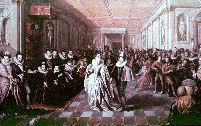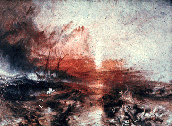

 Therefore
the Medieval painter who embellished the masterpiece known as the
Book
of Kells would have been baffled by our notions of himself as artist;
to him, artist and craftsman were the same thing.
Therefore
the Medieval painter who embellished the masterpiece known as the
Book
of Kells would have been baffled by our notions of himself as artist;
to him, artist and craftsman were the same thing.
 Little had changed by the end of the 16th century when we are told that "Art
or cunning every country nourisheth... [that] is to say, [artists are] cunning
men, and such as have any faculty or science, whether so ever they go shall
lack no living..." So by the time of Holbein
or Rubens,
art was still seen as a set of skills, valued as mainly a means of livelihood.
Little had changed by the end of the 16th century when we are told that "Art
or cunning every country nourisheth... [that] is to say, [artists are] cunning
men, and such as have any faculty or science, whether so ever they go shall
lack no living..." So by the time of Holbein
or Rubens,
art was still seen as a set of skills, valued as mainly a means of livelihood.
 By
the 18th century and the age of enlightenment, however, we begin to see a change
of attitude: Art is described as "A pursuit or occupation in which skill
is directed toward the ratification of taste or production
of what is beautiful." Here for the first time we hear that art is
associated with taste, and beauty, (though skill is still there). Mme. de Pompadour,
portrayed here by Francoise Boucher, participated in the development of new standards of
taste and elegance, but also did much to elevate the place of the artist in society.
In the eighteenth century artists and writers were frequent guests in aristocratic salons.
Fragonard,
Gainsborough ,
Tiepolo
are among the leading artists in this period.
By
the 18th century and the age of enlightenment, however, we begin to see a change
of attitude: Art is described as "A pursuit or occupation in which skill
is directed toward the ratification of taste or production
of what is beautiful." Here for the first time we hear that art is
associated with taste, and beauty, (though skill is still there). Mme. de Pompadour,
portrayed here by Francoise Boucher, participated in the development of new standards of
taste and elegance, but also did much to elevate the place of the artist in society.
In the eighteenth century artists and writers were frequent guests in aristocratic salons.
Fragonard,
Gainsborough ,
Tiepolo
are among the leading artists in this period.
 In the 19th century Matthew Arnold stated that "We mean by art not merely an
aim to please, but also pure and faultless workmanship." Arnold, who was the
foremost establishment arbiter of taste in the later 19th c. was being a little
defensive here. He was reaffirming the importance of skill,
while acknowledging that art should also aim to please; that is, create something
beautiful. The ideals of art as stated by Arnold are exemplified by the painting
on the right. But why was he being defensive about this well established idea
that artists exhibit skill? Because in the 19th century for the first time we
have dissent from this idea, expressed in the idea of the Avant Garde-
the notion that the creative powers of the individual artist are at the center
of what art is. The artist was now seen as the leading edge, the prophet of
new cultural ideas-- and this meant that the artist had begun to take more
extensive liberties with established ideas of technique, interpretation, and
suitable subject matter.
In the 19th century Matthew Arnold stated that "We mean by art not merely an
aim to please, but also pure and faultless workmanship." Arnold, who was the
foremost establishment arbiter of taste in the later 19th c. was being a little
defensive here. He was reaffirming the importance of skill,
while acknowledging that art should also aim to please; that is, create something
beautiful. The ideals of art as stated by Arnold are exemplified by the painting
on the right. But why was he being defensive about this well established idea
that artists exhibit skill? Because in the 19th century for the first time we
have dissent from this idea, expressed in the idea of the Avant Garde-
the notion that the creative powers of the individual artist are at the center
of what art is. The artist was now seen as the leading edge, the prophet of
new cultural ideas-- and this meant that the artist had begun to take more
extensive liberties with established ideas of technique, interpretation, and
suitable subject matter.
 The idea of the Avant Garde developed around 1800 following the revolutions
of the late 18th century. In the years following the revolutions in France and
America the Romantics
venerated the artist's creative powers; based on their creative talent,
they were held up as a special and sublime class, somehow separate from ordinary
mortals.
The idea of the Avant Garde developed around 1800 following the revolutions
of the late 18th century. In the years following the revolutions in France and
America the Romantics
venerated the artist's creative powers; based on their creative talent,
they were held up as a special and sublime class, somehow separate from ordinary
mortals.
The idea of the Avant Garde role of the artist also introduced the myth that
because they are ahead of their time, great artists could not be fully appreciated until
they were dead. The Romantic idea that a true artist must also be a "starving
artist" also emerges, because the Avant Garde artist could not, by definition,
participate in the establishments and institutions of his society; he must
remain an outsider to fulfill his critical, prophetic role.
Prior to the 18th century in a mostly preliterate society visual images were the way you got information about the world. Wealthy and powerful patrons knew this, and used art and artists to persuade and teach. They also employed artists to create status objects that would make their own lives comfortable and beautiful.
In the 19th century, the spread of democracy and the rise of the middle class changed the equation. The salon became the important institution which allowed artists to present an immense variety of visions and messages, judged and driven by a rising middle class that could now afford to patronize the arts. Annual exhibitions, or salons were held, and the public avidly followed the latest innovations.
There was still a belief, as there had been in the past, in the power of art to mold human minds. But now the artist controlled his own visions and the artist was seen as a race apart - a prophet. The artist's duty, according to the Avant Garde ethic, was to provide moral and spiritual leadership and to show beauty and meaning for the dawning industrial age. That is, he was to reinvent and expand the visual language to meet changing times.
These ideals led to the birth of Modernism in the later 19th century through such movements as impressionism , expressionism , and Symbolism. Modernism is a concept born in the industrial revolution. It was the expression of an urge to embrace the new realities and materials of the industrial age, and was expressed through literature, art, decorative arts and design. Underlying most of the modernist movements have been earnest efforts at social engineering- utopianism for the new industrial state that was taking shape.
Yet inevitably, as we shall see, there was also a counter-movement toward nostalgia and tradition, a resistance to the accelerating rate of change. This has often been expressed in visual arts by a taste for decorative detail, realism in painting, and a general preference for the elaborate. This was in contrast with the modernist tendency to simplify forms, reduce decorative detail, and retreat from realism. The emphasis on form also resulted in attention to the materials used, and the visual qualities they offer.
 |